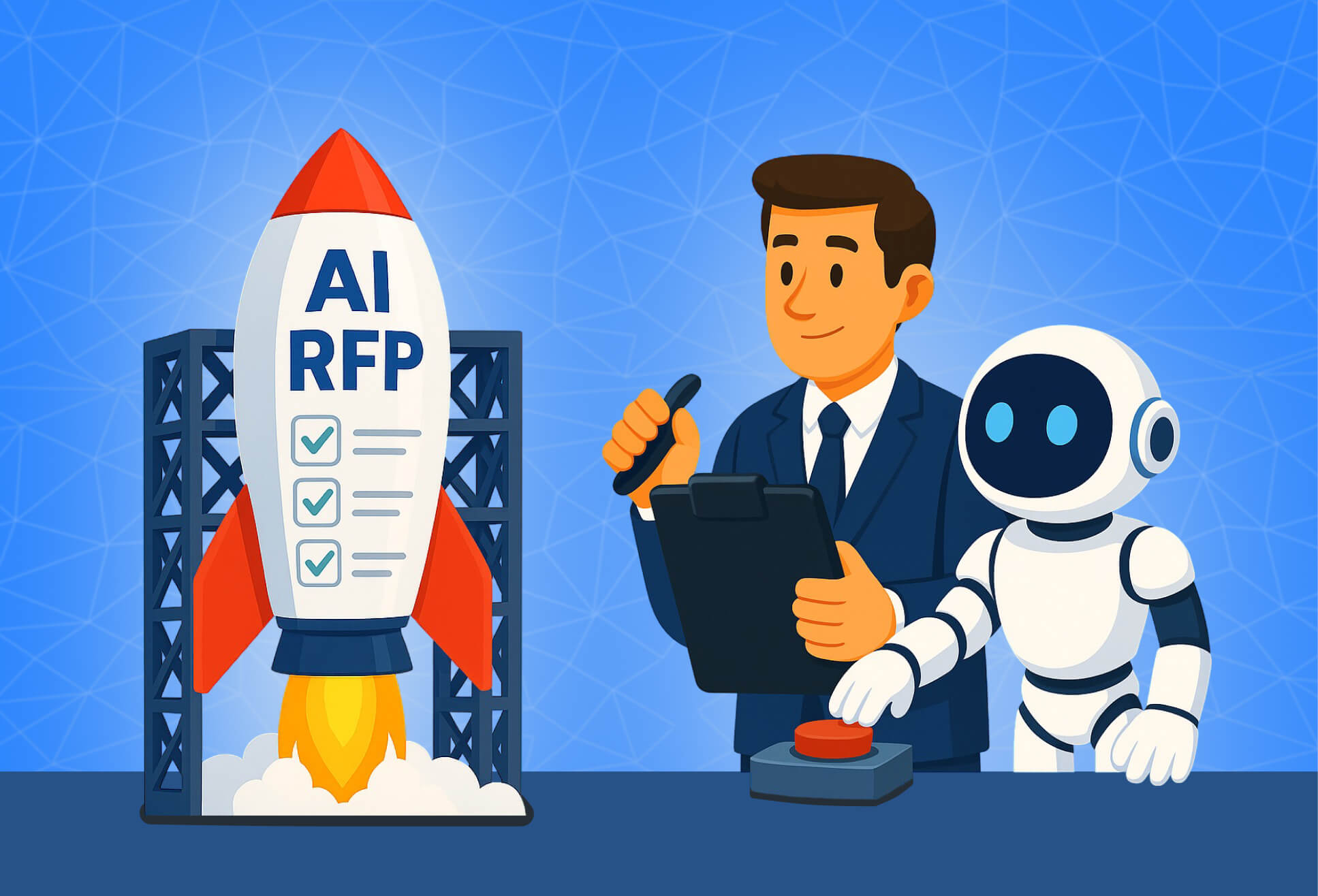AI Strategy Consulting: Crafting an Effective Enterprise AI Strategy
Many enterprises are experimenting with AI, yet few see real business impact. The difference often comes down to having a clear, well-structured AI strategy. This guide explains what an effective AI strategy looks like, how to build one, and how AI strategy consulting can help you align technology with business goals for maximum ROI.
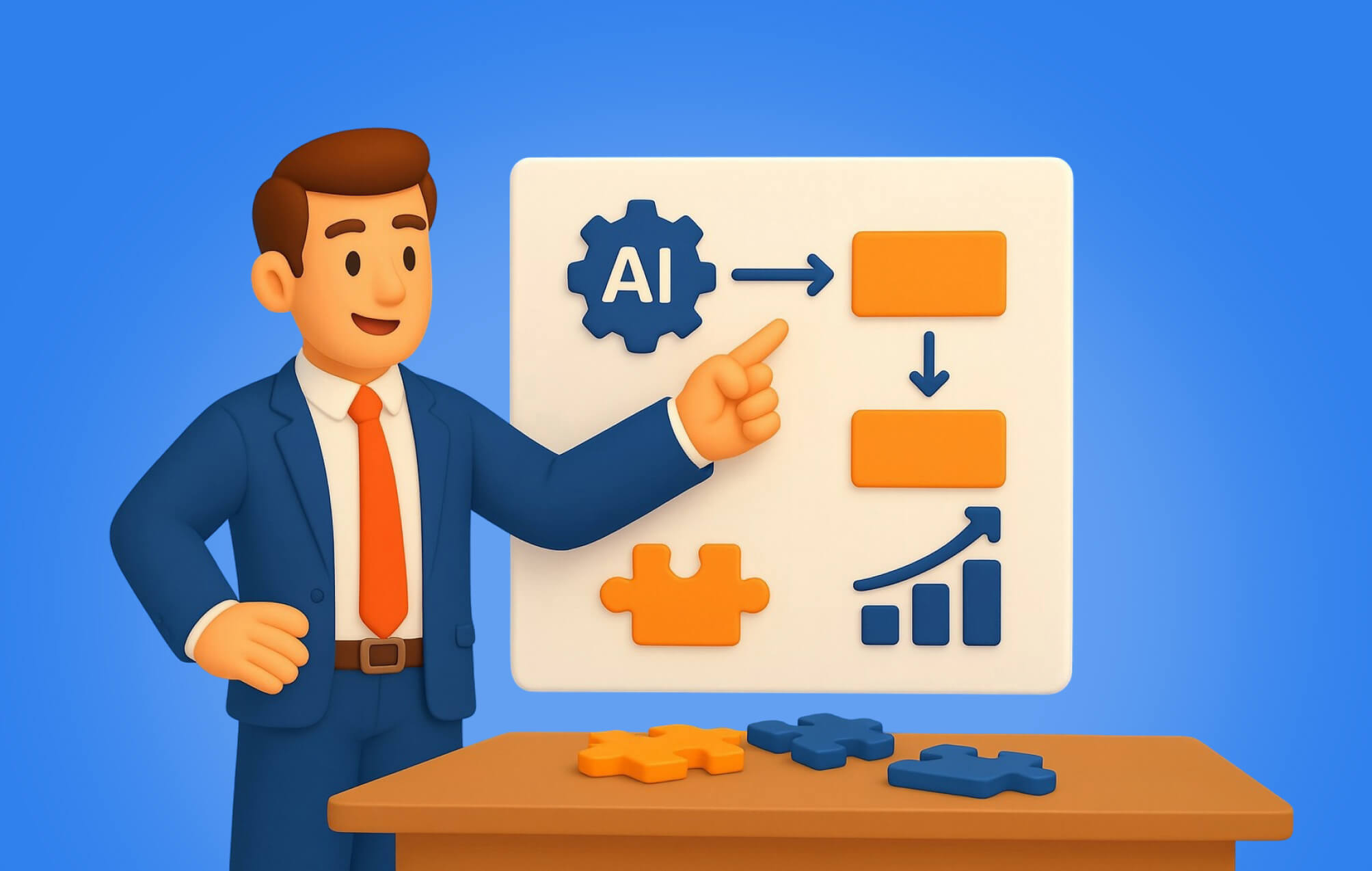
Today, AI is a strategic priority for businesses seeking growth and competitive advantage. However, many organizations still lack a clear AI strategy to guide their efforts. In fact, nearly 80% of companies have experimented with generative AI, but about the same percentage report no significant bottom-line impact from these efforts.
This “AI paradox” underscores the need for a well-planned strategy: ad-hoc AI projects rarely deliver value without alignment to business goals. An AI strategy provides that alignment, ensuring AI initiatives drive real business outcomes and are executed responsibly. This article outlines what an AI strategy entails, why it matters, and how to develop an effective AI strategy for your enterprise. It also offers best practices and insights into how AI strategy consulting and generative AI consulting services can help organizations navigate this journey.
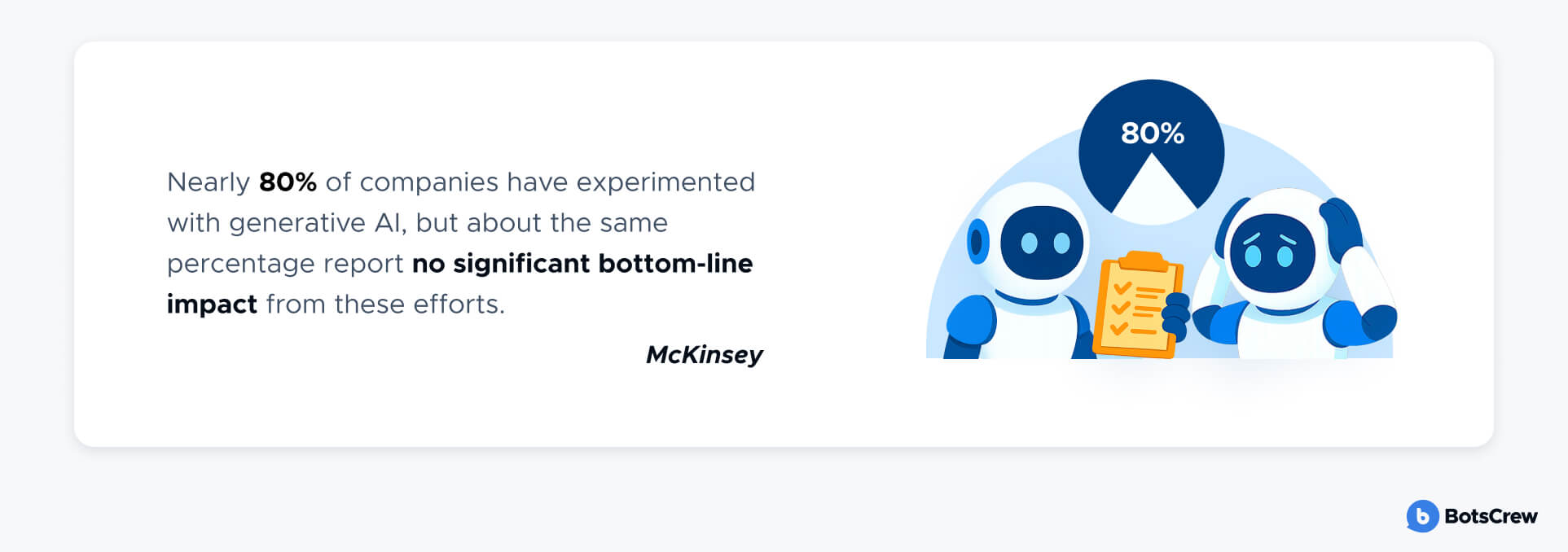
Why Businesses Need an AI Strategy
For C-level executives and business leaders, having a formal AI strategy is becoming essential. AI has the potential to boost efficiency, unlock new revenue streams, and transform customer experiences – but only if it’s approached strategically.
Research shows that companies with a bold, enterprise-wide AI strategy (championed by top leadership) are 3× more likely to succeed with AI initiatives. Yet, as of a recent survey, only 40% of organizations had an AI strategy in place, even though 66% viewed AI as critical to their success. Without a unifying strategy, AI efforts tend to remain siloed “science projects” with limited impact.
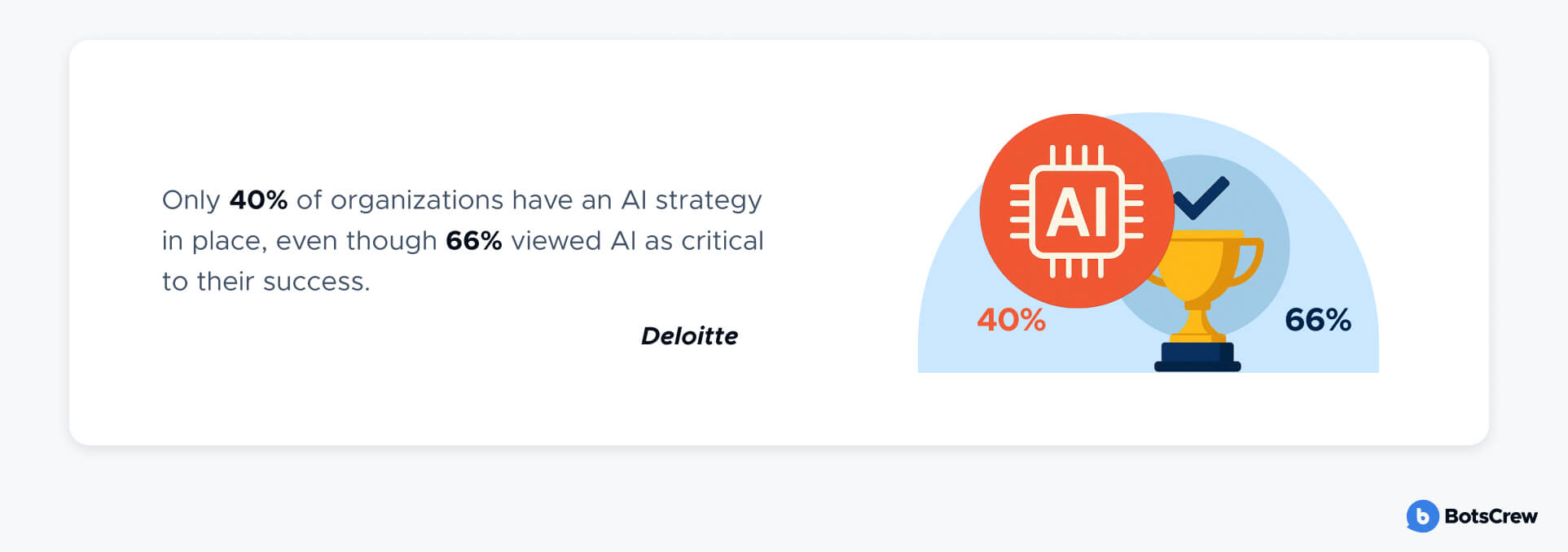
A well-defined AI strategy ensures that all AI and analytics projects are aligned with the core business strategy and key performance indicators. Rather than pursuing isolated use cases, leaders tie AI investments directly to business priorities like improving customer satisfaction, reducing costs, or opening new markets. This strategic alignment helps focus resources on the highest-impact opportunities. It also sends a clear message across the organization – from the C-suite to frontline employees – about the company’s AI vision and goals, which is vital for driving adoption. In short, an AI strategy connects AI initiatives to tangible business value, providing a roadmap for transformation.
Many firms have rushed into trendy generative AI pilots (like chatbots or content generators) only to see minimal ROI, because they lacked the data foundation or they tackled low-impact problems. A strategy helps avoid such missteps by prioritizing AI use cases that align with business needs and by preparing the organization to implement them effectively. It also builds a governance structure to manage risks (e.g., bias, privacy) before they become issues.
What is an AI Strategy?
An AI strategy is a comprehensive plan for how an organization will leverage AI to achieve its business objectives. Think of it as a roadmap that guides all AI-related investments and initiatives, ensuring they work in concert toward clearly defined goals. This strategy typically includes several elements: the business use cases for AI, the data and technology requirements, the needed talent and skills, and governance policies for responsible AI use. In essence, it outlines where and how the company will deploy AI, and what capabilities must be in place to do so successfully.
Key Components of an Effective AI Strategy
Let’s summarize the core components that make an AI strategy effective. These can be viewed as pillars or building blocks that any enterprise AI strategy should cover:
Business Alignment of AI Use Cases
Define clear business objectives for AI and select use cases that directly support those goals. Rather than deploying random AI projects, focus on applications that solve pressing business problems or create new opportunities. Every AI initiative in the plan should answer the question: How will this drive business value (revenue, profit, customer satisfaction, etc.)?
High-performing organizations maintain a portfolio of AI use cases tied to both efficiency gains and growth/innovation opportunities. For example, AI can be used for cost optimization and for creating new products – a balanced strategy pursues both.
Data and Technology Foundation
Ensure the organization has the necessary data assets, infrastructure, and tools. Data is the fuel for AI, so strategies must include robust data management (integration, quality, governance). They also outline technology needs: cloud services, ML platforms, model lifecycle tools (MLOps/LLMOps), and scalable architecture. Choosing the right infrastructure (on-prem vs. cloud, adopting automation, etc.) is key for enabling AI at scale.
Talent, Skills, and Culture
A recent survey reveals that companies face numerous challenges when implementing AI initiatives, with around 70% stemming from people- and process-related issues, 20% attributed to technology problems, and only 10% involving AI algorithms.
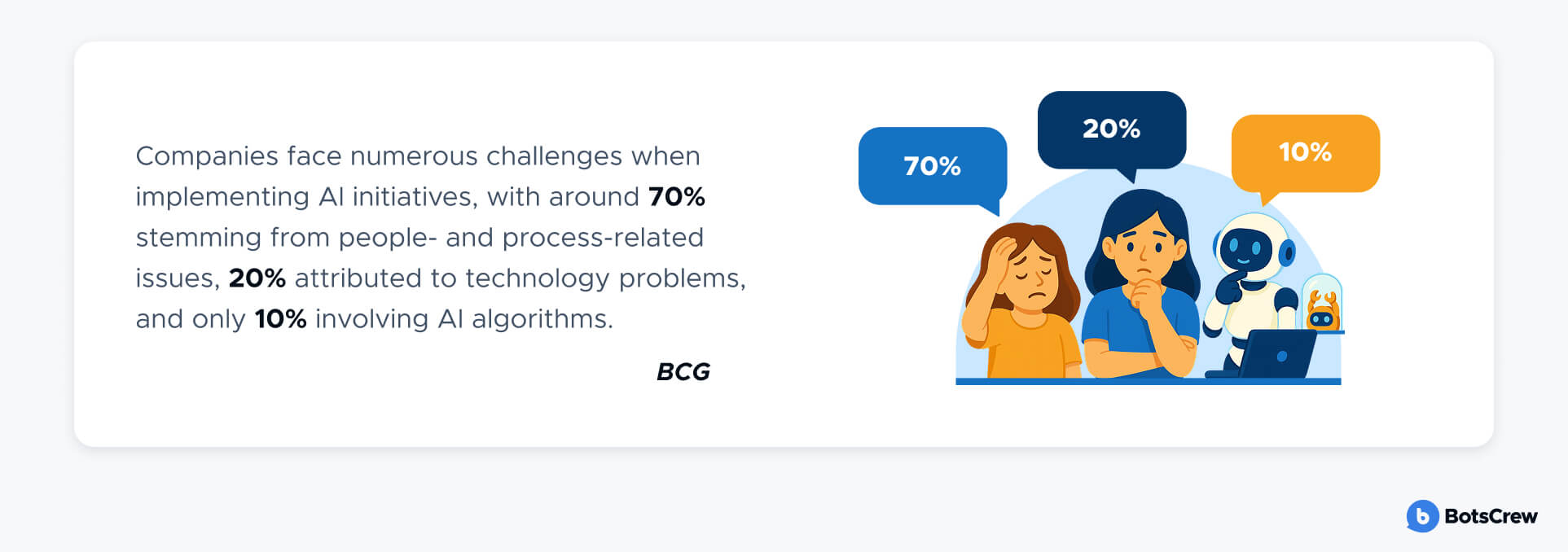
Recognize that AI transformation is as much about people as technology. A good strategy plans for talent development, acquisition, and change managment. This might involve hiring experienced AI professionals and consultants, training existing teams in data literacy and AI skills, and educating leadership on AI opportunities and limitations. Additionally, building a supportive culture is critical – one that encourages innovation, experimentation, and cross-functional collaboration on AI projects. Leadership should proactively address employee concerns (for instance, fears about AI automation) by communicating the benefits of AI and involving staff in the transformation.
“An analysis of AI leaders' capabilities, compared with other companies, shows that the key factors for scaling AI are largely people- and process-related, including change management, product development, workflow optimization, AI talent, and governance.” BCG AI Adoption Report
Governance and Risk Management
Integrate AI governance into the strategy from the start. This means establishing policies for ethical AI use, compliance with regulations (e.g., data privacy laws), and oversight mechanisms. Common practices include forming an AI governance committee or including AI in existing risk management processes.
Define guidelines on issues like avoiding bias in algorithms, obtaining proper consent for data usage, and ensuring transparency in AI-driven decisions. Governance provides the “guardrails” that let the organization innovate with AI confidently and responsibly. It also prepares the company for evolving AI regulations and public scrutiny.
AI Strategy Roadmap
Develop a phased roadmap to implement the strategy. This includes short-term and long-term AI initiatives, prioritized by impact and feasibility.
Often, companies will start with a few pilot projects to demonstrate quick wins and learn lessons. Successful pilots can then be scaled across the enterprise. The roadmap should map out these phases, with clear milestones (e.g. prototype, pilot, full deployment) and resource allocation. It’s essentially a timeline of how the AI strategy will unfold – for example, year 1 might focus on data platform build-out and a pilot in one department, year 2 expanding to more use cases, and so on. The roadmap is a living document; it should be revisited and updated as the organization progresses or as new opportunities (or challenges) arise.
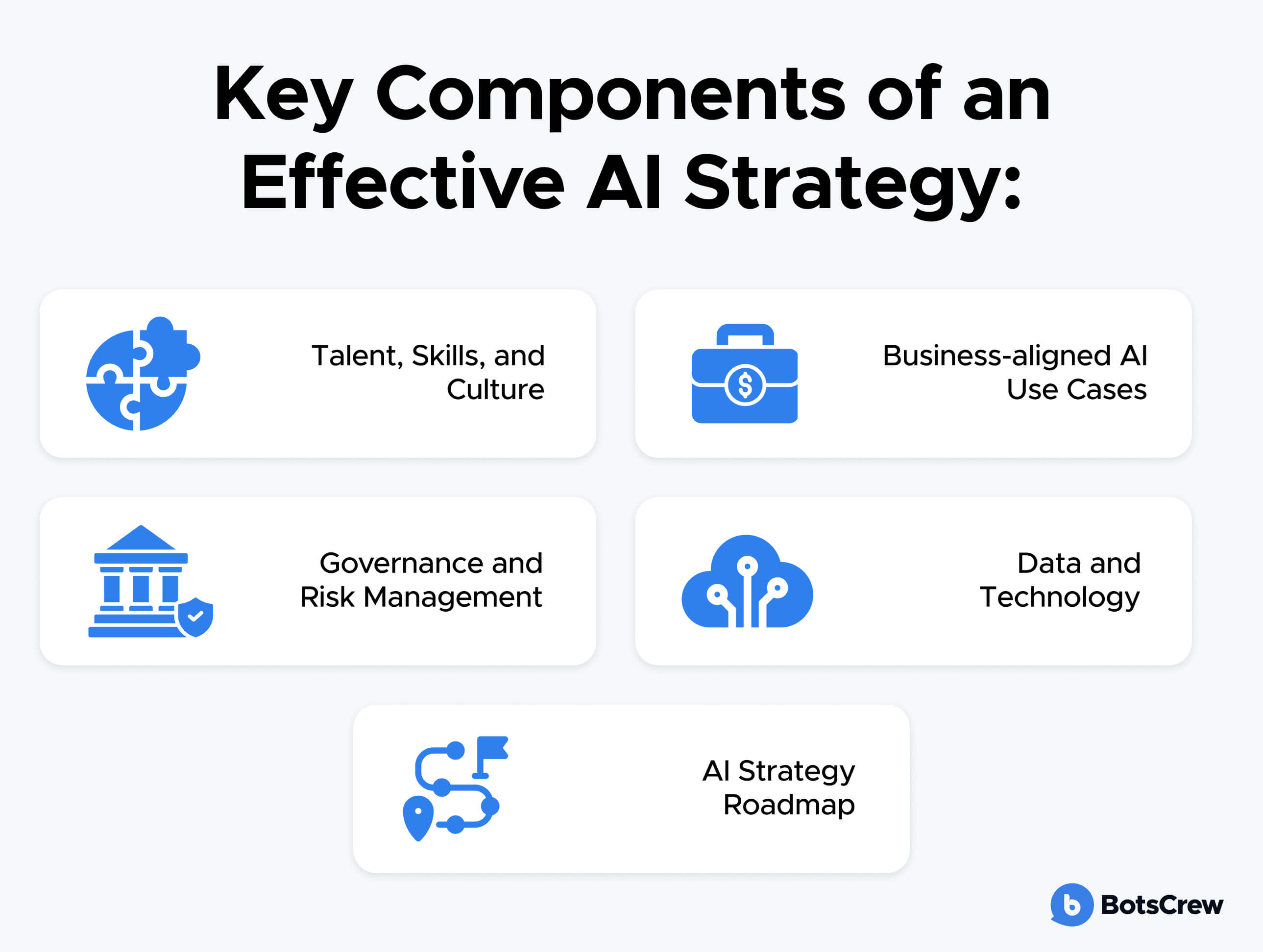
When these components are all addressed, an AI strategy becomes a solid framework guiding the enterprise’s AI journey. Neglecting any one component can undermine the whole strategy. For instance, great use case ideas will falter without the right data infrastructure, or a powerful AI platform may go underutilized if employees lack skills or trust in AI. Thus, holistic planning is crucial.
How to Create an Enterprise AI Strategy (Step-by-Step)
So, what’s the best way to develop an AI strategy for your company? Developing a comprehensive AI strategy involves a series of structured steps. Below is a step-by-step framework that enterprises can follow – whether you’re just starting or reevaluating an existing AI approach. Each step builds on the previous to ensure your AI initiatives are feasible, impactful, and aligned with business needs:
Assess AI Readiness
Begin with an honest evaluation of your organization’s current capabilities and gaps. This AI readiness assessment examines your technology stack, data assets, and workforce skills.
Key questions include:
Do we have the necessary data (and is it high-quality)?
Do we have computing infrastructure for AI workloads?
Do our teams have AI/ML expertise, or will we need training and hiring?
Also consider cultural readiness – how open is the organization to adopting AI-driven processes?
This initial assessment identifies what foundational work is needed. For example, you might discover data is siloed and requires integration before any AI project can succeed, or that employees need awareness on how AI can support (not replace) their roles. By pinpointing gaps early, you can address them in your strategy (e.g., investing in data platforms or partnering with an AI vendor).
Discover Your AI Readiness in Minutes
Take our quick AI Readiness Assessment to uncover your organization’s strengths, gaps, and next steps for building a winning enterprise AI strategy.
Define Clear Objectives
Next, clarify what you want to achieve with AI. This step is about tying AI to business strategy: identify high-level goals or problems to solve (e.g., improve supply chain efficiency by X%, increase customer retention, reduce processing time by Y hours).
Objectives should be specific and measurable. It helps to involve senior business leaders here to ensure AI goals align with overarching business objectives and KPIs. For instance, if the corporate strategy is to become a customer experience leader, an AI objective could be deploying an intelligent customer support chatbot to boost satisfaction scores. Importantly, prioritize objectives – most companies start with a handful of achievable goals where AI can make a real difference, rather than trying to “do everything” at once.
Identify and Prioritize AI Use Cases
With objectives in mind, brainstorm where AI can deliver value in your business. Engage stakeholders across departments to gather ideas and pain points – often, people on the front lines have insights into inefficient processes or unmet needs that AI could address.
Perform a business process analysis to spot opportunities for automation or smarter decision-making. List potential AI use cases and then evaluate each for impact (expected benefit to the objective) and feasibility (do we have or can we get the data, skills, budget?). You might score use cases and create a matrix of “quick wins” versus “long-term bets.” For example, automating a routine back-office task with AI might be low-hanging fruit for efficiency, while implementing an advanced predictive analytics system could be higher impact but also more challenging. The outcome of this step is a prioritized portfolio of AI initiatives to pursue. It’s often wise to pick a few use cases to start that are feasible, low-risk, but visible enough to show value – this builds momentum and organizational buy-in as you progress.
Validate Use Cases & Develop Business Cases
Before jumping into execution, take time to validate the selected use cases. This involves deeper analysis or small experiments to confirm the idea’s viability and value. For instance, you might do a proof-of-concept model on sample data to ensure the AI approach is technically sound. Or you might analyze the ROI: estimate the costs to implement vs. the expected benefit.
Validation may lead you to refine the use case or even drop some that looked good on paper but don’t hold up under scrutiny. By vetting use cases, you ensure that the ones moving forward have a strong justification and stakeholder support. The end result is a set of well-defined AI initiatives with approved business cases.
Create an AI Roadmap and Strategy Plan
Now, map out the AI strategy plan that ties everything together. This is your actionable roadmap for implementation. It should sequence the initiatives (from step 3) over a timeline, aligning with budget cycles and resource availability. Determine what happens in the short term (next 3–6 months), medium term, and long term. Assign ownership for each initiative (who is accountable?) and include key milestones. Also factor in dependencies – e.g. a predictive analytics project might depend on completing a data warehouse update first.
Building an AI roadmap forces you to be realistic about timing and ensures everyone knows the plan. It’s helpful to include quick wins early in the roadmap to demonstrate progress and ROI, which can secure ongoing support and funding. Make sure the roadmap is reviewed and approved by leadership, as it will guide cross-departmental efforts.
Pilot, Implement, and Scale
With a roadmap in hand, move into execution. Start by launching the pilot projects as planned. Keep these pilots well-scoped – for instance, test an AI tool in one business unit or on a subset of data – so you can manage risk and learn quickly. Monitor pilot results closely against your success metrics. Successful pilots will provide evidence (e.g. improved KPI by X%) to support larger rollouts. If a pilot underperforms, use it as a learning opportunity to tweak the approach.
Once a pilot proves its value, scale it up systematically: this could mean expanding to more users, more data, or additional business areas. Scaling requires planning for integration with existing systems and processes, training users, and possibly iterating on the solution to handle broader requirements. As AI solutions deploy, ensure you have change management in place (training, support) so that employees adopt the new tools effectively.
Monitor, Govern, and Refine
Implementing an AI strategy is not a one-and-done project – it’s an ongoing program. Establish mechanisms to monitor the performance of AI systems and track the business impact over time. This might involve dashboards for AI project KPIs or regular review meetings. Compare outcomes to the objectives set in step 2 and make adjustments as needed.
Additionally, continuously apply your AI governance: review models for ethical compliance, monitor for model drift or data changes, and ensure regulatory requirements are met. As the external environment or business priorities shift, be prepared to refine the AI strategy. Perhaps new AI technologies (like a breakthrough in AI agents) emerge – you’ll want to incorporate those if they align with your goals. Or maybe one initiative’s success opens up new possibilities. Treat the strategy as a living document; periodically update the roadmap and objectives. This iterative approach is crucial because AI itself is rapidly evolving.
Following these steps provides a structured path to develop and implement an AI strategy. It ensures you lay the groundwork (people, data, tech), focus on the right projects, and execute in a controlled, value-driven manner.
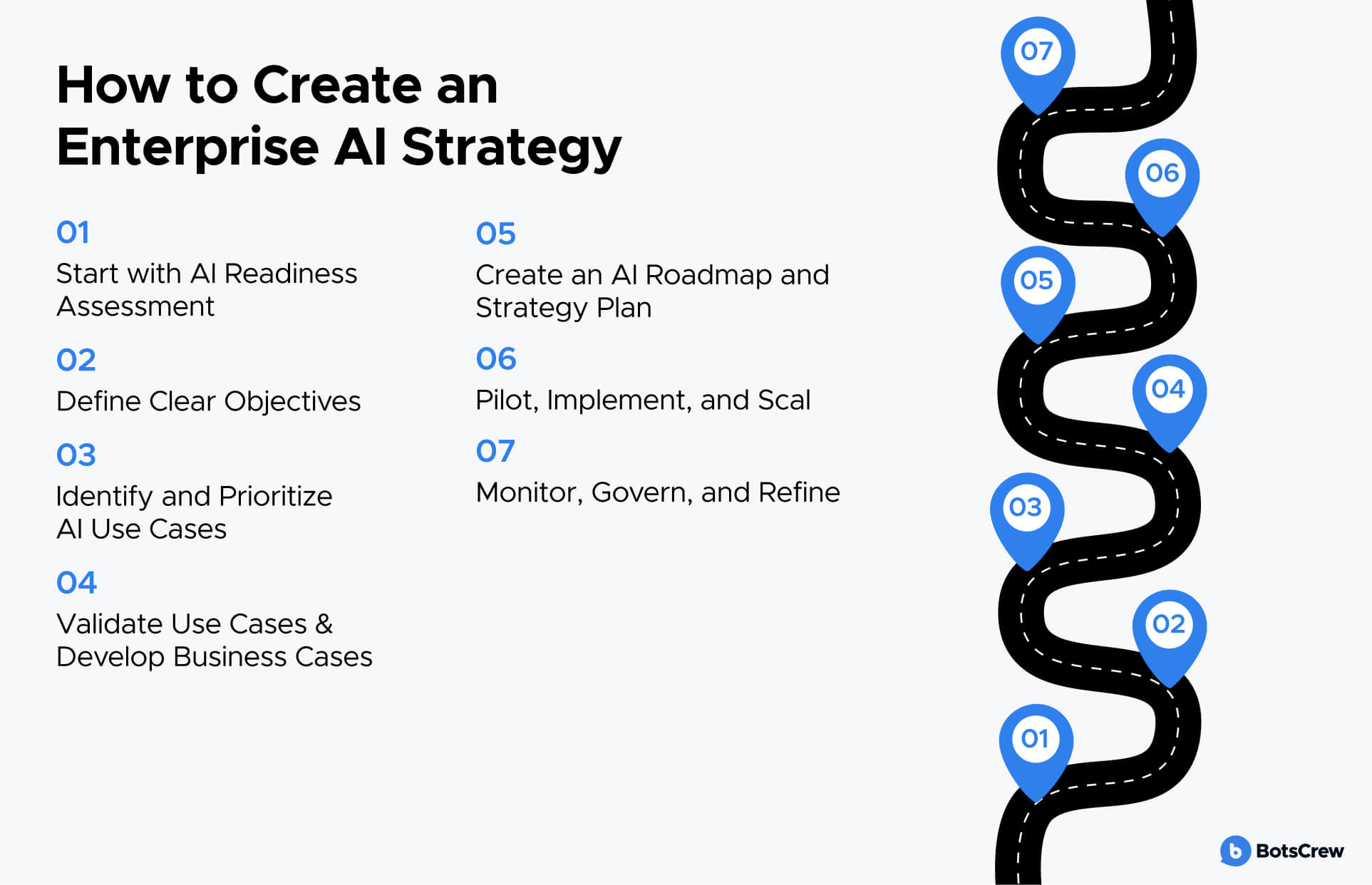
What Makes a Good AI Strategy? Best Practices and Tips
What differentiates a high-impact AI strategy from a mediocre one? Based on industry research and lessons from successful AI-driven companies, here are some best practices and tips for crafting an effective AI strategy.
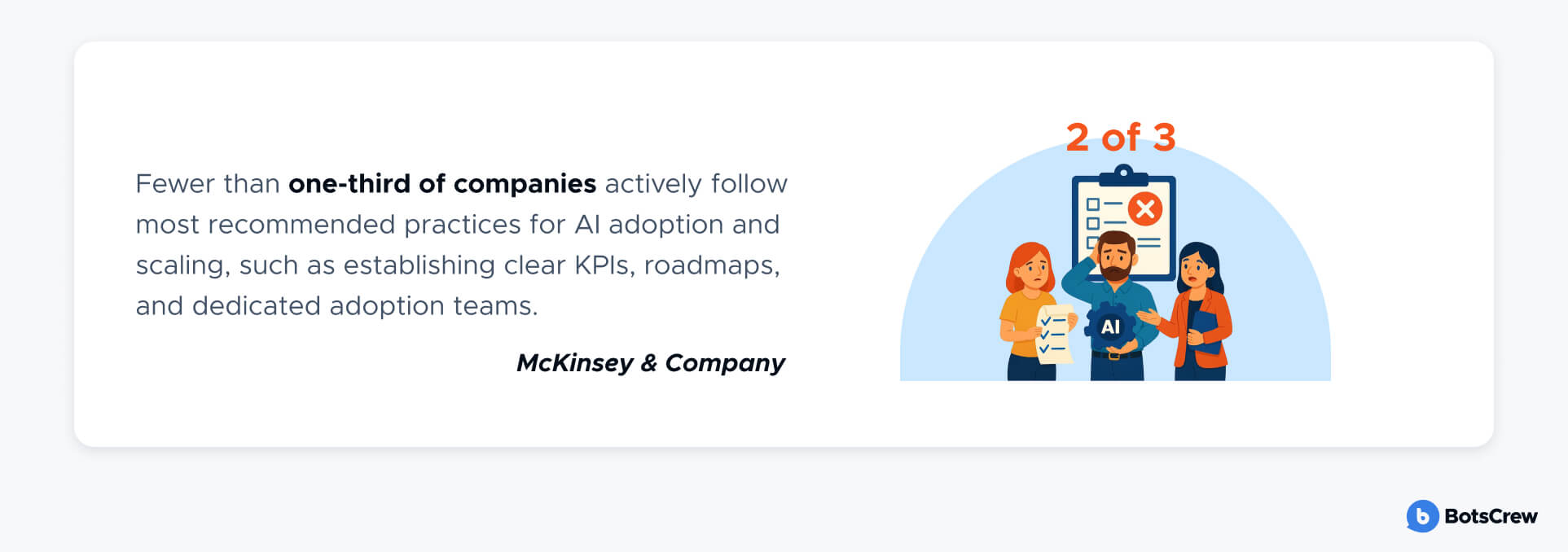
Align AI Strategy with Business Strategy
This is the golden rule. Ensure your AI initiatives directly support your company’s overarching goals and KPIs. The strongest AI strategies “begin with the organization’s north star” – i.e., they start by clarifying business priorities, then determine how AI can fuel those aims. For example, if your goal is to improve customer experience, your AI strategy might prioritize use cases like personalized recommendations or AI-powered support agents.
This alignment keeps AI efforts focused on delivering business value (revenue growth, cost reduction, customer satisfaction, etc.) rather than pursuing cool tech with no clear payoff. It also helps in securing executive buy-in, since you can articulate how the AI plan will help win in the marketplace, not just implement technology.
Secure Executive Sponsorship and Cross-Functional Buy-In
AI strategy must be championed from the top. C-level support – ideally the CEO or a Chief AI/Data Officer – is critical to drive an enterprise-wide AI agenda.
Companies see better results when CEOs or boards actively oversee AI governance. This oversight correlates strongly with positive bottom-line impacts. About 28% report CEO involvement in AI governance. McKinsey & Company
Leaders should communicate a clear vision for AI and allocate sufficient budget and resources. Equally, involve stakeholders from across the organization early on (IT, operations, business units, legal, etc.) in planning. This cross-functional collaboration ensures that the strategy is practical, addresses real needs, and has the buy-in of those who will implement it. It also helps break down silos.
One study found organizations whose leaders publicly communicate an AI vision are 1.5× more likely to achieve desired outcomes, underscoring the power of strong leadership and communication in AI success. Make AI a shared mission across departments, not just an IT project.
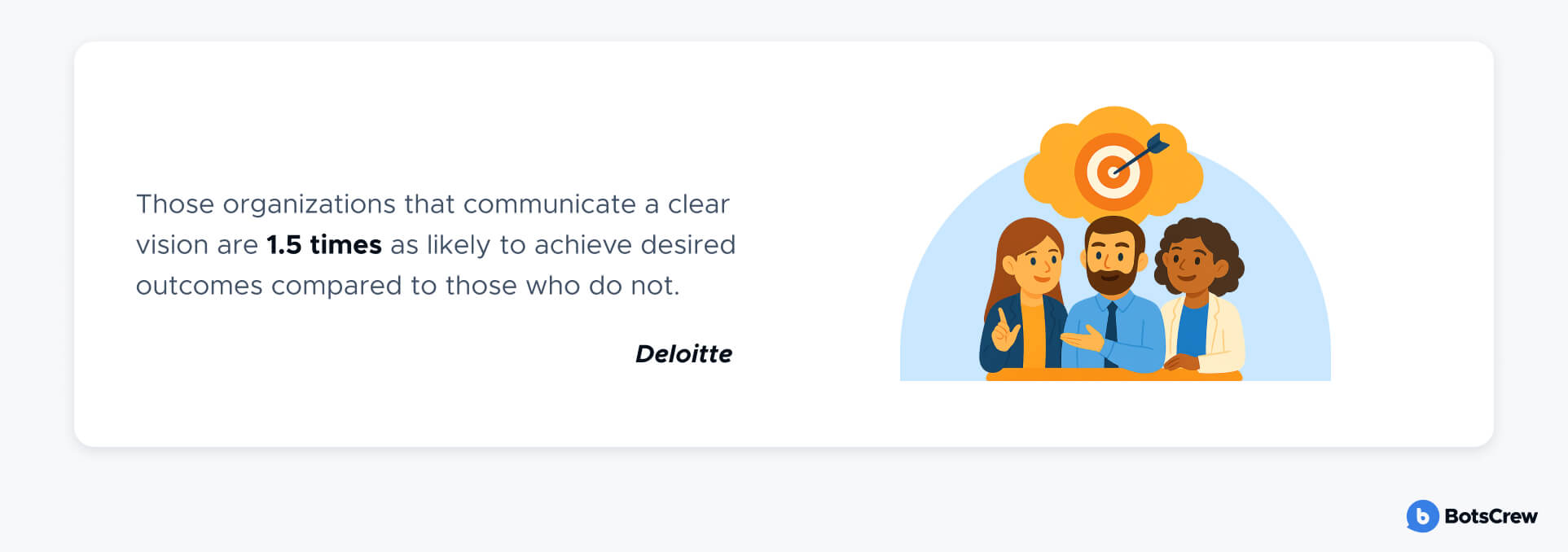
Start Small, Then Scale (Balance Quick Wins and Long-Term Bets)
A good strategy finds the right balance between short-term wins and long-term transformation. It’s often wise to begin with a few pilot projects that are manageable in scope but can demonstrate tangible value quickly. At the same time, the strategy should not lose sight of bigger, more transformative opportunities that take longer.
High-performing companies pursue both efficiency gains and new growth opportunities with AI– they use initial projects to gain efficiencies (cut costs, automate tasks) and reinvest those savings into more innovative AI applications (new product features, predictive analytics for new services, etc.). Essentially, think big but start small.
Invest in Data Quality and Infrastructure
Garbage in, garbage out is especially true for AI. Prioritize data readiness as a core pillar of your strategy. This means establishing strong data governance (to ensure data is accurate, consistent, and accessible) and upgrading infrastructure where needed (data lakes, cloud platforms, ML pipelines).
Develop & Attract the Right Talent
Even with the best strategy document, you need skilled people to execute it. Close the talent gap by investing in both upskilling existing employees and hiring specialists. Provide training programs on AI, data science, and emerging technologies for your current staff – this not only builds capability but also helps alleviate fears by empowering employees to work with AI. Simultaneously, bring in external talent where necessary (data scientists, ML engineers, AI project managers, etc.) to bolster your team.
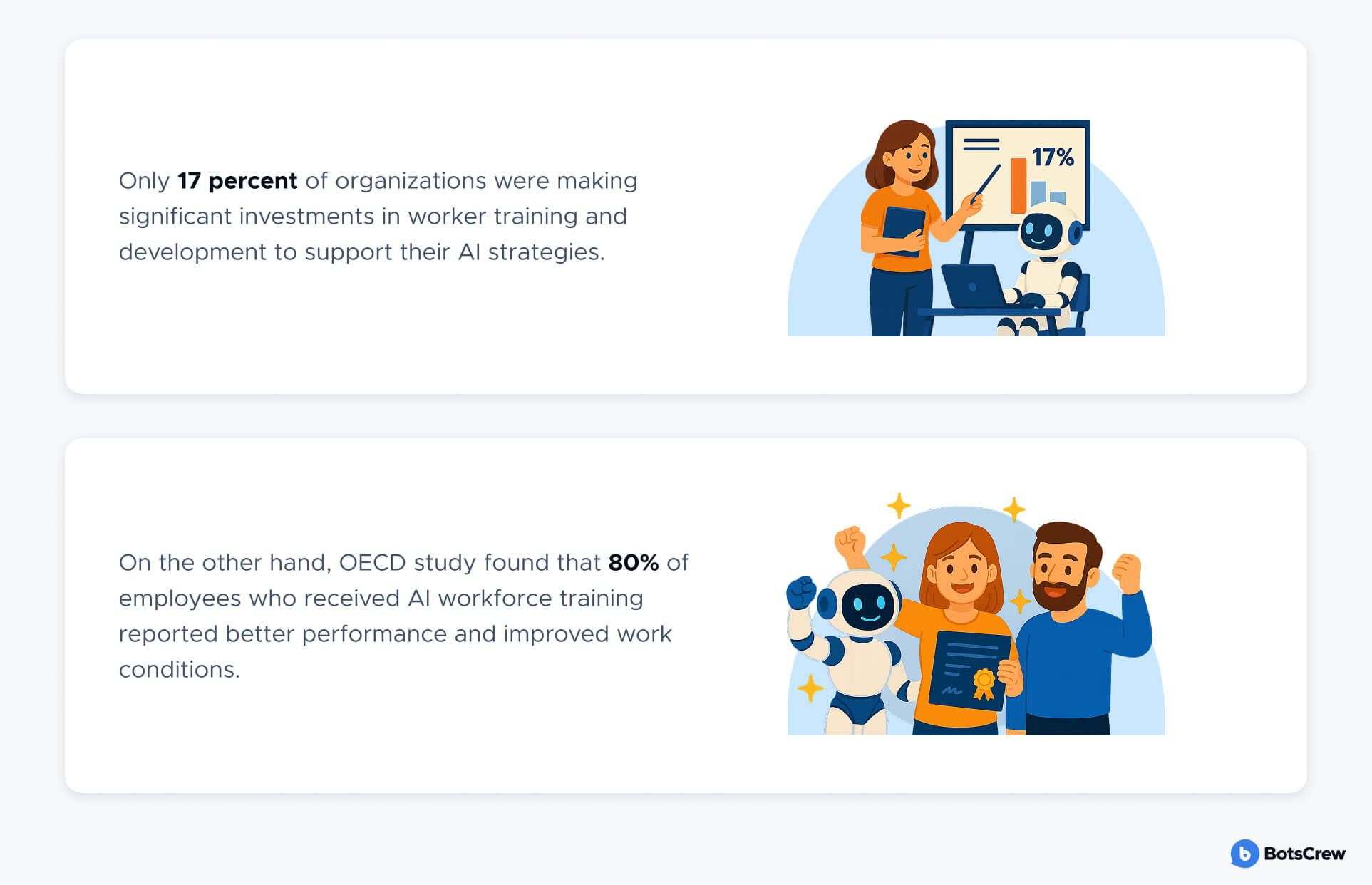
Embed AI Governance and Ethics from Day 1
Responsible AI is not a nice-to-have – it’s a must-have. Build ethical guidelines and risk checks into your AI strategy from the outset. This includes being transparent about AI uses, addressing bias in model development, ensuring privacy is protected (especially with customer data), and complying with any AI-related regulations in your industry. Set up a governance structure (like an AI ethics committee or incorporating AI review into existing risk committees) so that there is oversight on AI projects.
Measure Impact and Iterate
Define success metrics for your AI initiatives and track them rigorously. A best practice is to establish a few key KPIs for each AI use case and for the AI strategy as a whole.
For instance, an AI customer service bot might be measured by reduction in average handling time and improvement in customer satisfaction scores; at the strategy level, you might track overall ROI from AI projects or percentage of processes improved by AI. Regularly review these metrics. If certain projects aren’t delivering the expected value, investigate why – perhaps the model performance is lacking or adoption is low – and decide whether to pivot or persevere. On the flip side, scale up what’s working well.
By following these best practices, you greatly increase the likelihood that your AI strategy will be effective and deliver lasting benefits. In summary, a good AI strategy is business-driven, well-supported by leadership, starts with focused projects, builds on a strong data/tech foundation, involves skilled people, operates responsibly, and adapts over time. These qualities separate companies that truly transform with AI from those that merely dabble.
Turn Your AI Vision into a Clear Roadmap
Not sure where to start? Our AI Strategy Consulting team can help you identify high-impact use cases, validate them, and create a practical roadmap for execution.
AI Strategy Consulting: Expert Guidance from Vision to Execution
Developing and implementing an AI strategy can be a complex undertaking, especially for organizations new to AI or those facing resource constraints. This is where AI strategy consulting comes into play.
AI strategy consultants are experts who help businesses plan and execute their AI initiatives, providing outside perspective, deep expertise, and proven frameworks. Engaging AI strategy consulting services can accelerate your AI program and help avoid costly pitfalls. Here’s how consultants typically assist at each stage of the AI strategy journey:
Discovery & AI Readiness Assessment
Consultants often start by conducting a thorough assessment of your current state – essentially an AI readiness audit of your technology, data, and talent. They bring experience from other organizations to quickly identify gaps and opportunities. For example, a consulting team can evaluate whether your data architecture is sufficient for scaling AI or if you need a data lake or integration platform. They might also assess your organization’s analytics maturity using an established framework and gauge cultural readiness through stakeholder interviews. The result is a clear picture of where you stand and a set of recommendations to become AI-ready.
Use Case Ideation and Validation
AI consultants facilitate use case discovery workshops with your business and IT teams to brainstorm AI applications aligned to your goals. Thanks to their cross-industry knowledge, they can suggest innovative use cases you may not have considered and share best practices from similar projects they’ve seen elsewhere.
Crucially, they also help validate and prioritize use cases. Using their technical and business expertise, consultants can estimate the feasibility of each idea and the potential ROI. They might perform quick proofs-of-concept to test assumptions.
Strategy Formulation & Roadmap Development
Crafting the actual AI strategy document and roadmap is a core service of AI strategy consulting. Consultants work closely with your leadership to define the vision, objectives, and detailed plan. They often bring AI strategy frameworks and templates to structure the plan. This includes articulating how AI initiatives tie to business strategy (sometimes consultants help translate high-level business strategy into specific AI opportunities), outlining the required capabilities (data, tech, org structure), and establishing governance models.
A seasoned consultant will also incorporate change management and risk mitigation plans into the strategy. The deliverable is typically a comprehensive strategy report and a multi-year AI roadmap with prioritized projects, timelines, and resource estimates.
Generative AI Strategy & Implementation
Generative AI consulting companies can help companies evaluate where generative AI fits in their strategy and how to implement it responsibly. For example, consultants might help you pilot a large language model for internal knowledge management or deploy a generative AI customer service agent. They can advise on selecting the right generative AI platforms (OpenAI, Azure AI, etc.), setting up the necessary infrastructure (GPU servers, vector databases for retrieval-augmented generation), and integrating the solution into your workflows.
Just as important, consultants help establish guardrails for generative AI – from data usage policies to human oversight procedures – drawing on emerging best practices in this fast-moving field. Engaging experts here is valuable because generative AI is relatively new territory for many organizations; consultants who have done early projects can help avoid known issues (like model hallucinations or data leaks) and speed up your adoption of this technology.
Implementation Support and Project Management
The best strategies mean little without execution. AI strategy consultants often continue to support the implementation phase as advisors or project managers. They can help set up pilot projects by bringing in technical specialists (data scientists, engineers) or by coordinating with your in-house teams. Their project management ensures that the roadmap’s milestones are met and that different workstreams (data preparation, model development, infrastructure setup) stay on track.
Consultants also assist in tracking value realization, defining metrics for each project, and monitoring progress. If challenges arise (e.g., a model isn’t performing, or users are resisting adoption), they can suggest course corrections based on their past experiences. Essentially, they act as a partner to your teams, troubleshooting issues and keeping the execution aligned with the strategic vision. This hands-on support is especially useful for organizations that don’t yet have a large internal AI team or a dedicated Chief AI Officer to drive the program.
Change Management & Training
Because AI transformation has a significant human element, consultants often provide change management services. This can include helping develop a communication plan to articulate the AI strategy across the company, organizing training sessions and workshops to increase AI literacy among employees, and creating governance bodies or communities of practice for AI. The consultants transfer knowledge and best practices to your staff throughout the engagement, so your internal capability grows.
The overarching benefit of AI strategy consulting is speed and confidence. With expert consultants, companies can formulate a robust AI strategy faster than they might on their own (speed to strategy), and they can move forward with confidence that the plan is backed by proven methods and insights. This can ultimately accelerate AI implementation and ROI. Additionally, consultants provide an objective external viewpoint – they can challenge assumptions, ask the right questions, and ensure the strategy is ambitious yet attainable. For executives (like CIOs, CTOs, or CAIOs), having a consulting partner can de-risk the initiative and assure the board or stakeholders that the company is following industry best practices on its AI journey.
If your organization is embarking on AI for the first time or if you’re struggling to scale pilot projects into enterprise-wide impact, engaging AI strategy consultants could be a wise move. They can support everything from developing an AI governance framework and strategy to AI strategy execution and ongoing advisory. Ultimately, a good consulting partner aims not just to deliver a document but to equip your organization with the mindset and capability to carry the AI strategy forward.
Ready to Build an AI Strategy That Delivers Real Business Value?
Partner with our experts to design and implement a strategy that aligns AI with your business goals—and drives measurable results.






